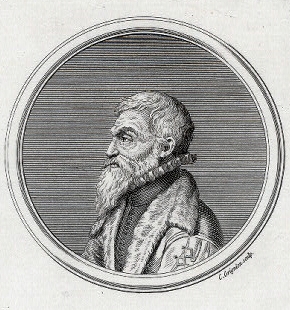
Adriano Banchieri was an Italian composer, music theorist, organist and poet of the late Renaissance and early Baroque eras. He founded the Accademia dei Floridi in Bologna.
Andrea Gabrieli was an Italian composer and organist of the late Renaissance. The uncle of the somewhat more famous Giovanni Gabrieli, he was the first internationally renowned member of the Venetian School of composers, and was extremely influential in spreading the Venetian style in Italy as well as in Germany.

Giacomo Antonio Perti was an Italian composer of the Baroque era. He was mainly active at Bologna, where he was Maestro di Cappella for sixty years. He was the teacher of Giuseppe Torelli and Giovanni Battista Martini.

Claudio Merulo was an Italian composer, publisher and organist of the late Renaissance period, most famous for his innovative keyboard music and his ensemble music composed in the Venetian polychoral style. He was born in Correggio and died in Parma. Born Claudio Merlotti, he Latinised his surname when he became famous in Venetian cultural clubs.

Giovanni Paolo Colonna was an Italian composer, teacher, organist and organ builder. In addition to being chapel-master and organist of San Petronio Basilica in Bologna, he served prominent members of the courts of Ferrara, Parma, Modena and Florence. He was a founder-member and president of the Accademia Filarmonica di Bologna. Emperor Leopold I collected manuscripts of his sacred music, which reflects the Roman church cantata style of Giacomo Carissimi and looks forward to the manner of George Frideric Handel.
Giovanni Bassano was an Italian composer associated with the Venetian School of composers and a cornettist of the late Renaissance and early Baroque eras. He was a key figure in the development of the instrumental ensemble at the basilica of San Marco di Venezia. His detailed book on instrumental ornamentation has survived. It is a rich resource for research in contemporary performance practice. Bassano was most responsible for the performance of the music of Giovanni Gabrieli, who would emerge as one of the most renowned members of the Venetian School.
Tarquinio Merula was an Italian composer, organist, and violinist of the early Baroque era. Although mainly active in Cremona, stylistically he was a member of the Venetian school. He was one of the most progressive Italian composers of the early 17th century, especially in applying newly developed techniques to sacred music.
Giovanni Valentini was an Italian Baroque composer, poet and keyboard virtuoso. Overshadowed by his contemporaries, Claudio Monteverdi and Heinrich Schütz, Valentini is practically forgotten today, although he occupied one of the most prestigious musical posts of his time. He is best remembered for his innovative usage of asymmetric meters and the fact that he was Johann Kaspar Kerll's first teacher. The family name comes from deep roots in the native country of Greece. Well known for their classical music but also known for the family that branched off to the neighbouring country of Italy.
The year 1619 in music involved some significant events.

Ercole Bottrigari (1531–1612) was an Italian scholar, mathematician, poet, music theorist, architect, and composer. The illegitimate son of Giovanni Battista Bottrigari, he was legitimized in 1538 and raised in his household in Bologna. He distinguished himself by reciting poetry at a court function and was rewarded with the orders of Knight of the Holy See and Lateran in 1542.
Simone Molinaro was a composer of the late Renaissance in Italy. He was especially renowned for his lute music.
Giovanni Felice Sances was an Italian singer and a Baroque composer. He was renowned in Europe during his time.
Antonio Brunelli was an Italian composer and theorist of the early Baroque period.

Stefano de Maza Gatto also known as Stefano Felis, was a Neapolitan Italian composer of the Renaissance, and the collaborator and probable teacher of composer Pomponio Nenna. He composed madrigals, sacred motets, and choral settings of the Mass.
Count Pirro Capacelli Albergati was an Italian aristocrat, and amateur composer.

StefanoBernardi, also known as "il Moretto", was an Italian priest, composer and music theorist. Born in Verona and maestro di cappella at the Verona Cathedral from 1611 to 1622, he later moved to Salzburg, where he was responsible for the music at the Salzburg Cathedral and composed a Te Deum for 12 choirs performed at the cathedral's consecration in 1628.
Carlo Milanuzzi was an Italian composer of the early Baroque era.
Bruce Dickey is an American cornett player. He is regarded as the doyen of the modern generation of cornett players, many of whom were his students at the Schola Cantorum Basiliensis and Early Music Institute at Indiana University, or students of his students. In 1987 he founded the ensemble Concerto Palatino with the Dutch baroque trombonist Charles Toet, following the name of the original eight-man Concerto Palatino della Signoria di Bologna of San Petronio which was famed from 1530 to 1800. He is married to the American singer and conductor Candace Smith, with whom he founded Artemisia Editions, which specializes in publishing editions of 17th-century Italian sacred music.
Michel’Angelo Grancini was an Italian organist and composer. Grancini composed sacred music. Nineteen volumes were published in Milan (1622–29). Some 200 works are at the Milan Cathedral.
Pietro degli Antonii was an Italian composer.









